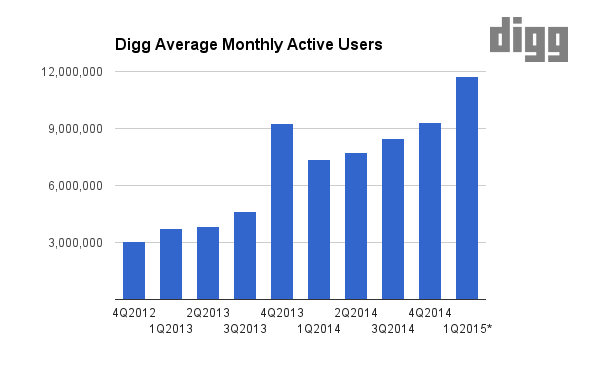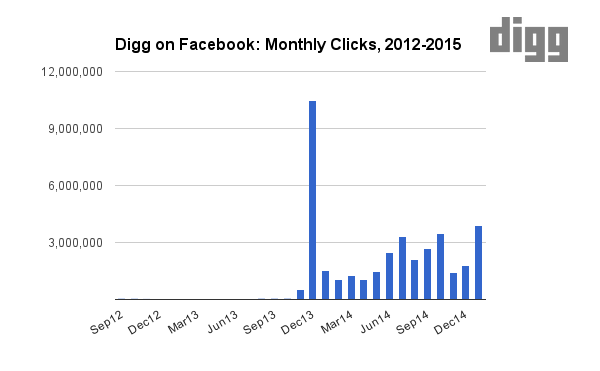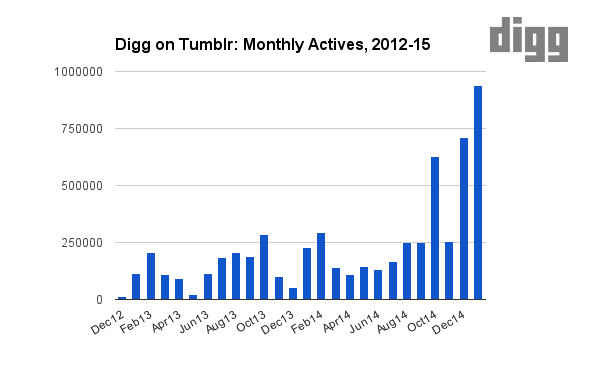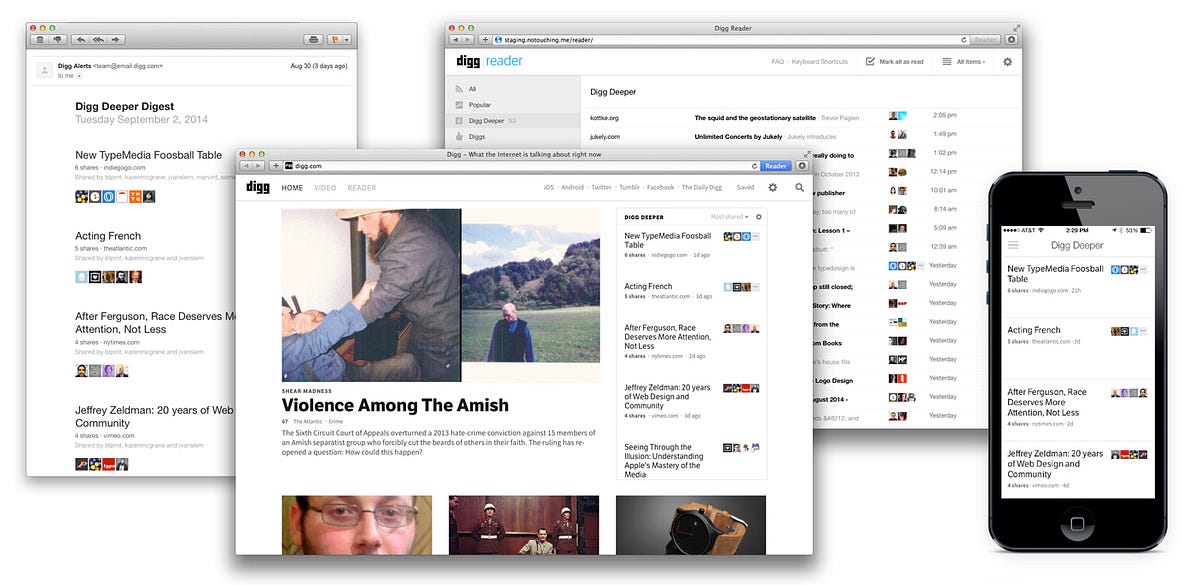Digg by the Numbers, 2015 Edition: An Exercise In Dig(g)ital Corporate Nudity
[Reposted from Medium, where it looks bestest.]
At the start of a new year, it’s tech company tradition/neurosis to do a swan dive into the previous year’s data in search of sunken treasures — patterns or insights that escaped notice in the daily rush of site metrics and KPI reports. I’ve been doing that over the past week, and thought it might be interesting to lift Digg’s hood and show some of our internal numbers from 2014. TL;DR: Digg had a terrific year, accelerating as the months progressed.
By way of background, we’re pursuing an unconventional strategy at Digg. Armed with a data infrastructure and some smart algorithms, Digg has editors — actual human beings — curate the most interesting stories and videos on the Internet and deliver them, as an act of judgment and with some degree of wit, to our users via our homepage, our iOS and Android apps, the Daily Digg email, and a rangeofsocialchannels. We think of our users as those who speak Internet — people who spend a fair amount of time online, who are curious, and who love news and great writing, as well as eye-catching videos. In short, those who want to learn and explore, and who enjoy both the highs and lows of Internet culture. For these people, the Internet is both wonderful and often utterly overwhelming — an endless scroll of stories, videos, blog posts (e.g., the one you’re reading), tweets, status updates, infographics, shared photos, gifs, alerts, and so on. Digg’s mission is to make sense of it all, to distill that vast daily river down to its most interesting and noteworthy gems. Tackling that problem from multiple angles, we also build awesome automated tools like Digg Reader and Digg Deeper that help our users navigate, manage, and make sense of their Internet.
It’s an amazing era for readers and watchers of creative work on the Internet. There are so many fantastic sites and apps generating great writing and compelling videos. But amid the resulting clamor for audience and attention, we’ve seen plenty of less edifying behavior — clickbaiting, churnalism, cut-and-paste repackaging of others’ work. Those sites tend to crash and burn.
We’re building Digg for the long term. We believe in quality. We’re making a bet that the future lies in driving attention by being smart and useful, not conjuring or regurgitating linkbait. Our goal is to send users out to what’s interesting, without cynicism, trickery, or favoritism. So we’ve been asking quantitative questions about the user experience at scale: How many people use Digg, our homepage, the apps, email, Digg Reader, Digg Deeper, social, etc.? How long do they spend on Digg, which parts, and how often? What do they read, what do they click, what do they ignore? When are they active, and where? Why are they at Digg, and what can we do to make it a more useful and enjoyable experience?
On to the 2014 numbers.
The Basic Number: Monthly Active Users
Let’s start with our most important metric. Here’s a graph that shows the growth in monthly active users (MAUs), quarter by quarter since Digg was relaunched by betaworks:

These are MAUs across all our channels (web, mobile, mobile web, email, social), as best we’re able to accurately account for them. We do a quarterly average in order to iron out seasonal changes and determine the overall trend. The Q1 2015 number is based on January performance.
While I’ve been happy to see strong, steady MAU growth over the year, I’m especially happy that the growth has been organic. While all our channels have been scaling, what’s notable is that direct traffic continues to dominate over search, social, and referral. Even at current scale, around 70% of our web traffic comes direct. This is a testament both to the Digg brand and to our ability to build products that users want to share with their friends. Digg in 2015 represents what the Internet is talking about, and a lot of people type our domain into their browsers and search engines each day. This was all accomplished without marketing: other than a few thousand dollars spent on one-off Facebook experiments, growth has been organic.
Social traffic
We get a lot of inbound traffic from Facebook and Twitter, and we drive a lot of activity there too. In just the last week, for example, about 600,000 Facebook users liked, commented, shared, or clicked on our posts. Since January 1, we’ve seen more than 3.5 million clicks from Facebook. Much of this has been on Digg videos. Generally, we’ve been getting better at Facebook, as you can see. You’ll also note that (a) during our first year, our Facebook activity was so small, it’s barely visible on the chart below, and (b) December 2013 was a huge outlier month, right after we launched Digg Video, to what seemed to be ardent (but fleeting) love from Facebook’s newsfeed algorithm.

Our total Facebook reach in the past week was slightly more than 7 million users — all organic. Over on Twitter, we’ve got a healthy 1.5 million followers.
Tumblr is also a significant social channel for us. We launched Digg’s blog on Tumblr in December 2012. By December 2014, we had 711,700 active users (“curators” in Tumblrese, meaning users who have liked, shared, or commented on a Digg post in that month); so far in January, we’re at 788,031. Tumblr’s often regarded as a pretty contained ecosystem, so we’re particularly proud of our success there.

On Vine, we have 24,400 subscribers; across Vine, we’ve triggered 30,849,284 loops.
Digg Video tends to do disproportionately well on social networks, confirming the truism that arresting video is the most share-worthy thing on the Internet. The all-time biggest video on Digg — “What You Get When You Pour Molten Aluminum Into An Ant Hill” — garnered more than 32 million views, most of them triggered by Facebook shares. Just this week, Digg Video has gotten more than 1 million views on an insane archery video that, I have to stress, you must watch. (Seriously, stop reading this for a minute and watch that video. Lars Andersen is a beast.)
As an aside, these types of super-performing videos are responsible for some of the month-to-month peaks and valleys of traffic on Digg. In December 2013, the aluminum anthill video pushed Digg’s MAUs up over 15 million; in October 2014, a couple of strong videos brought MAUs back over 10 million; and it looks like this month, January 2015, will also end well above 10 million.
On a related note, we’ve been doing a bunch of experiments with original Digg Videos to suss out what our audience finds compelling. For example, “Every Onscreen Death in Game of Thrones, In Under 3 Minutes.” So far, we’ve racked up 3.7 million views across 15 videos on YouTube. We’ve also been testing new formats, like infographics and a series of tappable essays on things like “How to Beat Jet Lag (And Why You Get It)” and “What Cavemen *Actually* Ate on the Paleo Diet”.
Traffic and Engagement Numbers
Digg is a complicated site to measure. On the one hand, we want to send our users efficiently elsewhere, as rapidly as they find interesting things to read or watch. On the other, we want them to stick around, and return often. TheDigg homepage is something users check frequently, but its goal is to send them away; Digg Reader and Digg Deeper are products users keep open all day. There’s a similar dynamic with our mobile and tablet apps. So we look to a bunch of different metrics, gathered by multiple analytics tools.
We track an internal metric of “reads,” which combines clicks (web, mobile, email, but not social) plus the number of stories read in Digg Reader. In 2014, we enabled between 2.5 to 3 million reads a day, give or take.
We track user engagement. Among Digg’s web users, the average session duration in 2014, measured by Google Analytics, was 4 minutes and 16 seconds (i.e., not bad!).
We close pay attention to how users get to Digg. Our ~70% direct traffic rate has remained pretty consistent even as Digg has more than tripled its MAUs.
And a fundamental metric for Digg is user loyalty. Looking at Chartbeat, 2014 visitors to the Digg homepage, video pages, and Digg Reader were 51.5% “loyal users,” 30.9% “returning users,” and 17.5% “new users.” (A “loyal user” is a user who has visited Digg 8+ of the last 16 days; a “returning user” is a user who who has visited Digg less than 8 times in the last 16 days; and a “new user” is visiting Digg the first time in the past 30 days.)
Digg Deeper
One of our most interesting product launches in 2014 was Digg Deeper, which turns a social stream like Twitter into a high-value list of the very most-shared links among your friends, updated in real time. Effectively, Digg Deeper is your Twitter friends recommending the links they collectively think you should pay attention to. Feature-wise, it’s pretty great. Personally, I love being able to see my friends’ tweeted comments on each story. Rather than scroll endlessly to read disjointed tweets about a given story, Digg Deeper pulls it all together into a cohesive and digestible snapshot. Since we launched in August, sign-ups have been solid and steady, though not huge — more than 150k in all. Digg Deeper users do, however, tend to be obsessive.

Revenue & How to Grow It
A major Digg workstream for 2014 was to get consistent revenues from advertising. By December, we were doing exactly that. We have been very deliberate about monetization — we want to do it in a way that fits our user experience, delivering something genuinely valuable to users. Our primary ad unit is a sponsored post called “Startups We Digg,” “Apps We Digg,” “Pants We Digg,” “Groceries We Digg,” etc., depending on the thing being sold. It’s what some would call a native ad, meaning that it fits into the look and feel and editorial tone of the site (though clearly marked as an ad, of course!). We run only one sponsored post a day, and it’s always a product or service that the Digg team is genuinely into. (Check them out.) They are primarily sold as performance-based ads, aimed at companies selling products, services, or subscriptions that fit the Digg audience of Internet lovers, media junkies, and early adopters.

In 2015, the challenge is to couple user and product growth with the right monetization experience, one that moves with the grain of our product experience — one that speaks Internet, and that scales. Specifically, we aim to grow revenues overall (more than 3x); to introduce new ad options, particularly for brand and entertainment advertisers; to test and decide on mobile and email ad options; and to prove that we can scale without dropping in quality or messing up Digg’s clean and uncluttered user experience.
The Return of The Digg Effect
The Digg Effect describes the surge in traffic that hits a publisher when one of its stories makes it to the Digg homepage. (It’s a flavor of the Slashdot Effect). More broadly, that dynamic is what makes Digg, with its cross-cutting, low-cost, high-leverage curation model, a valuable contributor to the online publishing ecosystem. People visit Digg to see what’s interesting and noteworthy from across the Internet; in turn, publishers that produce great work benefit from a wave of readers who might not otherwise have seen it.
Though we’ve certainly not (yet) returned to the towering heights of the old Digg circa 2007, publishers are once again noticing a potent Digg Effect. Though most publishers don’t talk publicly about their traffic stats, we saw a steady flow of posts and Tweets noticing its return. Here’s a few:
The “Digg effect” is back. — MarketingLand
You might be surprised to learn that content site Digg was our third largest source of traffic [this] year, surpassing Reddit and Google Search. …. Under Betaworks’ stewardship, editors and algorithms (instead of users) now choose which articles are on the front page. Digg has a clean design, very interesting articles, and appears to be blossoming in its second act. — Priceonomics
Front page link on @digg provides some serious traffic. Time to upgrade the site as the hamsters are struggling. — Jake Kouns
Wow, really interesting to see: Being on the front-page of @digg still drives great traffic. —Leo Widrich
Can I just say that I’m blown away that @digg is the third largest referrer to my Thoughts on Google+ post? — Chris Messina
You can always tell when Digg or someone similar picks up on a@mosaicscience piece — traffic shoots up 500%. — Mun-Keat Looi
Traffic from @digg on this piece about Vegas’ changing blackjack rules suggests you’re all secret gambling addicts. — Nicholas Jackson
Users + Engagement (& How To Grow Them)
Looking ahead, 2015 is going to be a year marked by scaling and major product launches. We’ve built a data platform and a custom content management system called Canvas that undergirds a fairly efficient and high-leverage business. We have a low cost-per-read / cost-per-view / cost-per-click — a thin layer of editors sitting atop an awesome set of social-data-rich crawling, sorting, ranking, scoring, and flagging tools. To give you a sense of scale, Digg’s editorial team consists of just six people who, as a team, work nearly 24 hours a day, 7 days a week. In 2014, that small team curated 22,013 homepage stories, 3,344 videos, and 227 originally-written pieces.
So even with the expense of editors on top of our data infrastructure and CMS, we have figured out how to effectively curate a vast and overwhelming Internet for a sizable and coherent audience. With the benefit of our existing technology stack, we think our model of [editors + algorithms] is one that can efficiently be scaled to other languages and other parts of the world. And so that’s one thing we’re going to pull off this year.
We live in a world where there is a vast oversupply of things to read, creators clamoring for your attention. One thing that is scarce, and highly valuable, is awesome curation. Digg provides awesome curation, plus clean design, a witty voice, and a bunch of useful tools and products.
To become more useful to our users — more enjoyable as well as more essential — we’re starting to incorporate social features, bringing some of the best dynamics of the old Digg back into the new Digg. With Digg Deeper, we’ve now started to bake personal connections and conversations back into our products. We’ve heard from many readers that they want to be able to see what their friends are digging, and to spark or join conversations with friends about those links. The evolution of Digg in that direction is going to accelerate dramatically in 2015. The trick, as always, is to add feature depth to Digg without overcomplicating the simple design that’s appealed to our readers.
In sum: Lots to come.
P.S.: Can’t fail to mention this: We’re hiring! Android lead, mobile dev, front-end, back-end, platform engineers, dev/ops, editorial, revenue/sales, and more. Check out the Digg Jobs page.
